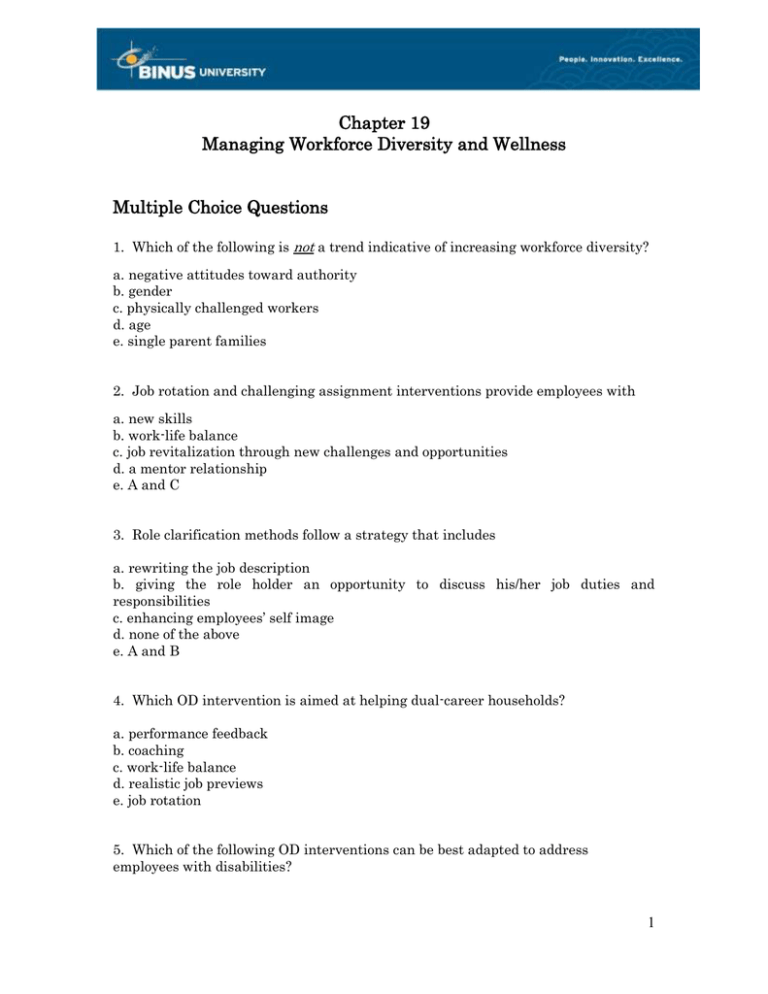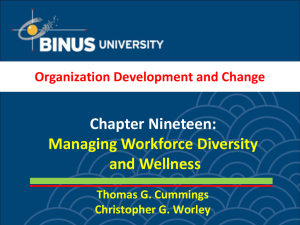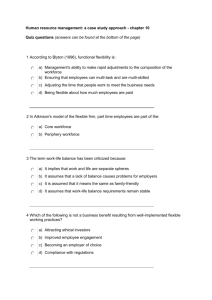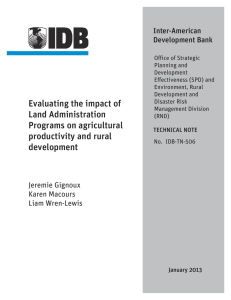Chapter 19 Managing Workforce Diversity and Wellness Multiple Choice Questions
advertisement

Chapter 19 Managing Workforce Diversity and Wellness Multiple Choice Questions 1. Which of the following is not a trend indicative of increasing workforce diversity? a. negative attitudes toward authority b. gender c. physically challenged workers d. age e. single parent families 2. Job rotation and challenging assignment interventions provide employees with a. new skills b. work-life balance c. job revitalization through new challenges and opportunities d. a mentor relationship e. A and C 3. Role clarification methods follow a strategy that includes a. rewriting the job description b. giving the role holder an opportunity to discuss his/her job duties and responsibilities c. enhancing employees’ self image d. none of the above e. A and B 4. Which OD intervention is aimed at helping dual-career households? a. performance feedback b. coaching c. work-life balance d. realistic job previews e. job rotation 5. Which of the following OD interventions can be best adapted to address employees with disabilities? 1 a. career planning and development b. performance management c. work design d. A and C e. all of the above 6. Cultural diversity in the workplace affects which organizational areas? a. rewards systems b. career planning and development c. employee involvement d. values, work ethics and norms e. all of the above 7. The “age” trend suggests that a. there will be a decreasing number of older workers in the near future b. older workers will demand better working conditions c. competition for younger workers will be intense d. A and B e. A and C 8. EAP’s typically adopt a philosophy that a. organizations should not interfere in the private lives of their employees b. organizations have the right to expect certain standards of performance c. organizations have no rights concerning employee behavior d. A and B e. A and C 9. Which is/are true of stress? a. it involves physiological responses b. it can be positive c. it can ultimately lead to withdrawal behaviors d. all of the above e. A and C only 10. Stress management is concerned with a. preventing negative stress outcomes b. changing organizational conditions to find the right levels of stress c. ignoring employees’ to stress the right behaviors d. all of the above 2 11. The preventative approach to stress management typically starts with which method(s)? a. charting stressors b. health profiling c. identification of Type A or Type B personality d. A and C e. A and B 12. Employee stress and wellness interventions acknowledge the connection between a. b. c. d. worker productivity and training programs organization effectiveness and role clarification worker health and organization productivity A and B True/False Questions 13. There is decreasing evidence that work-related stress can contribute to a variety of ailments, such as tension headaches, backaches, and high blood pressure. 14. Role clarification deals with helping employees better understand the demands of all their life’s roles. 15. Workforce diversity refers primarily to the increasing number of ethnic backgrounds entering the workforce. Essay Questions 16. Describe the major diversity trends facing organizations and how organizations might use various OD interventions to respond to these trends. 17. Discuss methods to diagnose employee stress and the specific OD interventions aimed at alleviating it in the workplace 3







